What happened at the Bretton Woods Conference in 1944?
Topic of Study [For H2 History Students]:
Paper 1: Understanding the Global Economy (1945-2000)
Section B: Essay Writing
Theme II Chapter 1: Reasons for growth of the global economy
Historical Context
Amidst the ongoing World War Two, world leaders from 44 nations, including USA and Soviet Union, attended a conference at Bretton Woods, New Hampshire in July 1944.
As the Great Powers envisioned a world that is free from Nazi and Japanese occupation, there were calls for a global financial order. Two institutions were established following the Bretton Woods Conference: The International Monetary Fund (IMF) and the International Bank for Reconstruction and Development (IBRD) [later known as the World Bank].
1. The International Monetary Fund
Before the Conference, Harry Dexter White (Special Assistant to the US Secretary of the Treasury) and John Maynard Keynes (advisory to the British Treasury) carried out plans in 1942.
Their drafts include the creation of organisations that provide financial assistance to countries that are experiencing balance of payment deficits. Eventually, there was common consensus to pursue fixed exchange rates at the global level.
On 21 April 1944, leaders of the Allied Powers released a joint statement that officially declared the creation of the IMF. The IMF was responsible for the maintenance of a system of fixed exchange rates.
In particular, it was based on a Gold-US Dollar exchange rate system. Till 1971, the USD was pegged to gold at $35 per ounce. Other foreign currencies were fixed to the USD. By doing so, USD became the anchor for stable currencies and facilitated international trade and investments.
Additionally, the IMF was also charged with the responsibility to provide short-term financial assistance to countries that experience temporary deficits in their balance of payments.
2. The World Bank
The second product of the Bretton Woods Conference was the IBRD. Both White and Keynes observed that many developing nations were lacking funds to develop their infrastructure.
Furthermore, the devastation caused by World War Two left these countries in dire need of post-war recovery, which incurred large expenditures. Therefore, the IBRD was set up to provide financial assistance to Europe, Japan and developing nations for reconstruction.
At the early stages, USA provided a major source of financing for post-war recovery, as evidenced by the Marshall Plan. Nevertheless, the IBRD played its part, as seen by its first issuance of loan to France.
Later, the organisation was renamed as World Bank. It expanded into multiple sub-entities, such as the International Development Association in 1960 (IDA) that lends to low-income countries and the International Finance Corporation in 1956 (IFC) that supports private investments in countries.
3. General Agreement on Tariffs and Trade (GATT)
The third feature was formed much later in April 1947. During the Bretton Woods Conference, proposals were made to establish an International Trade Organisation. However, USA did not ratify the treaty, thus an alternative arrangement was carried out, known as the GATT.
The GATT was introduced to encourage free trade between countries. This is done through regular meetings that facilitate periodic bargaining, in which member countries agree to reduce tariffs for various products.
In 1995, GATT was replaced by the World Trade Organisation (WTO). It was a milestone achievement as more countries agreed to liberalise their markets and reduce tariffs.
What can we learn from this article?
Consider the following question:
– How far do you agree that the Bretton Woods system was the main reason for the growth of the global economy from 1945 to 1973 [to be discussed in class]?
Sign up for our JC History Tuition and learn how to apply your knowledge to essay questions for GCE A Level History.
The H2 and H1 History Tuition feature online discussion and writing practices to enhance your knowledge application skills. Get useful study notes and clarify your doubts on the subject with the tutor. You can also follow our Telegram Channel to get useful updates.
We have other JC tuition classes, such as JC Math Tuition and JC Chemistry Tuition. For Secondary Tuition, we provide Secondary English Tuition, Secondary Math tuition, Secondary Chemistry Tuition, Social Studies Tuition, Geography, History Tuition and Secondary Economics Tuition. For Primary Tuition, we have Primary English, Math and Science Tuition. Call 9658 5789 to find out more.








